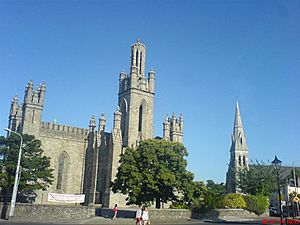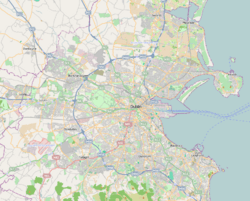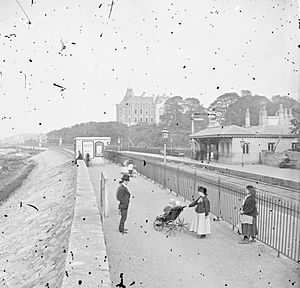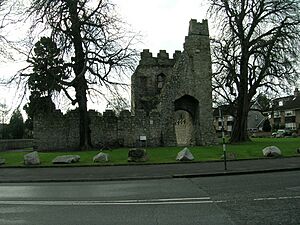Monkstown, County Dublin facts for kids
Quick facts for kids
Monkstown
Baile na Manach
|
|
|---|---|
|
Suburb
|
|

Monkstown showing to the left Monkstown Church, Dublin (Church of Ireland) and St. Patricks Church (Roman Catholic) to the right
|
|
| Country | Ireland |
| Province | Leinster |
| County | Dún Laoghaire–Rathdown |
| Population
(2006)
|
|
| • Urban | 6,369 |
| Time zone | UTC±0 (WET) |
| • Summer (DST) | UTC+1 (IST) |
| Eircode (Routing Key) |
A94
|
| Area code(s) | 01 (+3531) |
| Irish Grid Reference | O221292 |
Monkstown (Irish: Baile na Manach), once known as Carrickbrennan, is a suburb in south Dublin, Ireland. It is located along the coast between Blackrock and Dún Laoghaire. It also borders Sallynoggin and Deansgrange further inland.
The area of Carrickbrennan is a big part of the civil parish of Monkstown.
Contents
History of Monkstown
A church was built in Carrickbrennan (the old name for Monkstown) before the 8th century. It was named after Saint Mochonna, a bishop from Skerries. In 1200, the King gave the land of Carrickbrennan to the Cistercian monks of Saint Mary's Abbey in Dublin.
The monks built their farm (called a grange) near the church. A village slowly grew around it. The monks' land reached as far south as Bulloch harbour near Dalkey. Here, the monks built a fishing harbour protected by a castle.
Monkstown Castle and Its Owners
In 1539, King Henry VIII gave the Monkstown lands to Sir John Travers. He was in charge of weapons in Ireland. John Travers lived in his castle from 1557 until he died in 1562. The property then went to James Eustace, who was married to Mary Travers.
In 1580, the castle was used by rebels. After this, it was given to Sir Henry Wallop. Later, the lands were returned to Mary, who was now a widow. She later married Gerald Alymer. When she died in 1610, the castle went to the Chevers family.
The Chevers family lived in the castle for many years. In 1653, during the time of Oliver Cromwell, the family was told to leave Monkstown. They moved to Killyan in County Galway. But in 1660, Walter Chevers got his Monkstown Castle estate back.
Later, the Archbishop of Armagh, Michael Boyle, bought Monkstown. His son, Murrough Boyle, 1st Viscount Blesington, made the castle much bigger. He made it one of the best homes in the area.
Monkstown's Growth and Changes
Until about 1800, Monkstown was mostly countryside. There were large houses owned by rich Dublin merchants. The Monkstown Church (Church of Ireland) was already built, but it was smaller than it is today.
Two small local rivers met in the area now called Pakenham Road. The coastline was rough and rocky. There was a harbour that went over 100 yards inland. Dún Laoghaire (then called Dunleary) was just a few houses.
On November 18, 1807, a terrible storm hit southern Dublin. Two sailing ships, the Rochdale and the Prince of Wales, were blown onto the rocks. One hit at Seapoint and the other at Blackrock. About 400 people died that night. Many bodies washed up on the shore at Monkstown. Most victims were buried in Carrickbrennan Churchyard. This disaster helped lead to the building of Dún Laoghaire Harbour.
The building of Dún Laoghaire harbour helped Monkstown grow. Montpelier Parade was the first of many new rows of houses. The arrival of the railway in 1837 had an even bigger impact. It changed the shape of the coast. Monkstown became a place where people lived and traveled to work in Dublin. Most houses along Monkstown Road were built over the next 30 years.
After World War II, more areas like Castle Park and Richmond were built. Newer developments like Brook Court also added more homes. This means there is not much space left for new building projects today.
The diaries of Rev John Thomas Hynes give us a good look into daily life in Monkstown. He was a Catholic bishop who lived there from 1861 to 1868. His diaries talk about things like gas lighting, mail services, and local news.
Built Heritage
Monkstown has two old and well-known churches. Saint Mary's Church of Ireland was built in 1831. Saint Patrick's Catholic Church was built in 1866. Both are on Carrickbrennan Road. Saint John's Church was built in the 1860s. It was later updated and re-opened in 1985.
Other religious buildings include the Kingdom Hall of the Jehovah's Witnesses. There is also the Meeting Hall of the Society of Friends (Quakers). The Friends Burial Ground is also nearby.
Monkstown Castle was likely built in the 12th or 13th century. It was built by the monks from the Abbey of the Virgin Mary.
Monkstown is also known for its coastline. It has many historic buildings from the Victorian, Georgian, and Edwardian times. A famous building in the Salthill and Monkstown area is a Martello Tower. It is located at Seapoint beach.
Getting Around Monkstown
The DART train serves the area. You can find stations at Seapoint and Salthill and Monkstown.
Dublin Bus also has several routes that go through Monkstown. These include routes 7, 7a, 7n, S8, and 63.
An Aircoach service starts in Dalkey and connects Monkstown to Dublin Airport. This service runs 24 hours a day.
Sports in Monkstown
Monkstown has a rich history in sports.
- Monkstown Lawn Tennis Club started in 1877. It was the very first tennis club in Ireland!
- Monkstown Football Club was founded in the village in 1883. They later moved to Sandymount in 1901.
- Monkstown (Dublin) Boxing Club began in 2004. Their gym is in the Mounttown Community Centre.
- Farm Utd Football Club was formed in 1935. They use the Monkstown Community Centre for their changing rooms.
- Monkstown also has a Brazilian jiu-jitsu club called Ribeiro Jiu Jitsu Ireland.
- A hockey club, Monkstown Hockey Club, is based at the Rathdown School.
Culture and Arts
Comhaltas Ceoltóirí Éireann has its main office in Monkstown. This group works to promote Irish culture, especially traditional Irish music. BirdWatch Ireland, an organization for bird lovers, is also based here.
For many years, Monkstown had a puppet theatre called the Lambert Puppet Theatre. It was a family business that hosted an international puppet festival. The theatre also appeared on national television for RTÉ. It closed after a fire.
Education
Monkstown has several schools for different ages.
- Monkstown Educate Together National School (METNS) is a primary school. It welcomes children from all backgrounds.
- Monkstown Park Junior School and CBC Monkstown Park are fee-paying schools.
- Holy Family National School is another primary school.
- Scoil Lorcáin is a Gaelscoil. This means all classes are taught through the Irish language.
- St. Oliver Plunkett N.S. is a special school. It helps children with specific learning difficulties.
Christian Brother's College is located on the old estate of Charles Haliday. It has two schools: a junior school with about 200 students and a secondary school with over 500 students. CBC teaches boys from junior infants up to their final year. The college recently updated its buildings and added a new extension.
Representation
Monkstown is part of the Dáil Éireann constituency of Dún Laoghaire. This means that people living in Monkstown vote for representatives in the Irish Parliament (Dáil Éireann) as part of the Dún Laoghaire area.
Famous People from Monkstown
Many well-known people have lived in or are connected to Monkstown:
- D. J. Carey, a famous hurler (Irish sport player)
- Nuala Carey, a weather presenter on TV
- Cathy Davey, an Irish singer-songwriter
- Chris de Burgh, a popular singer-songwriter
- The Edge, the guitarist from the band U2
- Marian Keyes, a best-selling Irish author
- Paul McGuinness, the manager of the band U2
- Charles Mitchel, the first newsreader on RTÉ television
- Christy Moore, a well-known singer-songwriter
- Cillian Murphy, a famous actor
- Bláthnaid Ní Chofaigh, a TV presenter
- Sinéad O'Connor, a globally recognized singer-songwriter
- Ryan Tubridy, a popular TV and radio presenter







